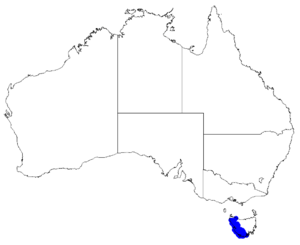Boronia elisabethiae facts for kids
Quick facts for kids Boronia elisabethiae |
|
|---|---|
| Scientific classification | |
 |
|
| Occurrence data from Australasian Virtual Herbarium |
Boronia elisabethiae is a special plant that belongs to the Rutaceae family, also known as the citrus family. You can only find this plant growing naturally in Tasmania, Australia. It's a small, woody shrub that can stand a bit upright or spread out low to the ground. It has leaves made up of smaller parts, and its flowers are white to pink with four petals.
What Does it Look Like?
Boronia elisabethiae is a woody shrub that can grow up to 20 cm (8 in) tall and 50 cm (20 in) wide. Its leaves are "pinnate," which means they look like a feather with smaller leaflets branching off a main stem. Each leaf has between three and nine of these small leaflets.
The whole leaf is about 5–11 mm (0.2–0.4 in) long and 5–18 mm (0.2–0.7 in) wide. It sits on a tiny stalk called a petiole, which is 1.5–3 mm (0.06–0.1 in) long. The leaflet at the very end is narrow, about 2–8 mm (0.08–0.3 in) long and 0.5–1 mm (0.02–0.04 in) wide. The leaflets on the sides are similar but a bit longer.
The flowers are white to pink. They grow either by themselves or in small groups of up to three. You can find them where a leaf meets the stem (called an axil) or at the very ends of the branches. Each flower has a small stalk about 1–4 mm (0.04–0.2 in) long.
The flower has four triangular sepals, which are like small leaves that protect the bud. These are about 1.5–3 mm (0.06–0.1 in) long. It also has four petals, which are the colorful parts, measuring 3.5–6 mm (0.1–0.2 in) long. Inside, there are eight stamens (the parts that make pollen), and they are slightly hairy.
This plant flowers from November to March. After flowering, it produces a fruit called a capsule. This capsule is quite small, about 3 mm (0.1 in) long and 1.5 mm (0.06 in) wide.
How it Got its Name
Boronia elisabethiae was officially named in 2003 by a scientist named Marco F. Duretto. He wrote about it in a scientific journal called Muelleria after finding a sample near Lake Pedder in Tasmania.
The second part of its name, elisabethiae, was chosen to honor Elisabeth Murdoch. She was a very generous supporter of the Royal Botanic Gardens Victoria, which is a famous garden in Australia.
Where it Lives
This type of boronia plant likes to grow in open, grassy areas called heath and button grass moorland. You can find it in the western parts of Tasmania.

